JUBILEE BRIDGE – SAMTREETI SETU
ENGINEERING MASTERPIECES OF THE INDIAN RAILWAYS
Within a kilometre of the oldest Portuguese Church of eastern India, built in 1599 AD, and only two hundred metres from the classic Imambara at Hooghly, stands the “Jubilee” Railway Bridge, opened by Lord Dufferin, Viceroy and Governor General of India, in 1887, commemorating the Golden Jubilee year of the reign of Queen Victoria, then the Empress of India. Alas, though lakhs of tourists and pilgrims visit the town of Bandel every year, just thirty five kilometres north of Kolkata, very few pause to notice the engineering splendour of this iconic Railway Bridge, the first over the River Hooghly, between Bandel Jn. on the west to Naihati Station on the east bank. Commissioning of this bridge made it possible to connect North and West India to Bengal, Assam and the North East of the subcontinent, by rail transport for the first time in history.
It has always been a wonder as to why the Railway pioneers of the 19th century chose this particularly difficult site to ford the river, since at this location, the mighty Hooghly boasts of a perennial water flow of 27 metres depth. Being near the Bay of Bengal, the bridge substructure regularly suffers from the stresses emanating from repeated tidal movement. There is a belief that the Indian Railway Engineers of yore wanted to present their beloved Monarch a gift of unparalleled engineering accomplishment, on the Golden Jubilee year of her reign, as a befitting salute from her loyal subjects.
Jubilee Bridge has a cantilever truss structure, constructed exclusively by riveting. Its unique construction includes pendulum bearings, which perhaps are not seen in any other bridge in the country. The bridge abutments are made of brick masonry whereas the piers are partly of steel.
Opened to traffic on 16th February, 1887 the bridge was designed by Bradford Leslie and A. M. Rendel. Fabrication and erection were completed within a record period of five years. The bridge has a central span of 360 feet length and two side spans of 420 feet each. In 1910, a gauntleted track was laid on the bridge to allow wider rolling stock.
In 1999, after having served the nation for over a century, the need for replacement of the Jubilee Bridge was acutely felt by the Indian Railways. Therefore, during 1999-2000, a new double line bridge was sanctioned to be built. Named Sampreeti Setu, the new bridge is located by the side of the old bridge. With a Double-D well foundation, this bridge comprises of two end- spans of 132.5 metres each and a central span of 150 metres.
Inspired by the world-renowned Sydney Harbour Bridge in Australia, Sampreeti Setu has been designed with a continuous steel bow-string superstructure, with open web girder of 417 metres length and height of 45 metres. A span arrangement of such dimensions has not been successfully accomplished in Indian Railways or elsewhere in India before.
Another landmark achievement of the new bridge is of the use, for the first time in the Indian Railways, of spherical bearings. This has been done keeping in mind the vagaries of this location.
As the sun went down, at 15.10 hours on 17th April 2016, 13141 Up Teesta Torsa Express became the last passenger carrying train to cross the Hooghly over the historic Jubilee Bridge. With this, the curtain came down upon this great saga of railway engineering. The same afternoon, one of the most aesthetic bridges of modern India, the Sampreeti Setu, was simultaneously operationalised, with the passing of the Bandel-Naihati Dn. EMU at 14.00 hours, first passenger train over it.

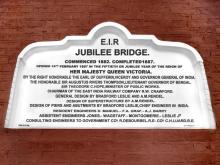
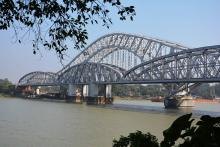
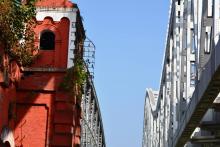
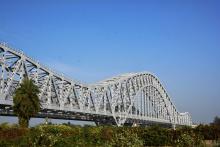
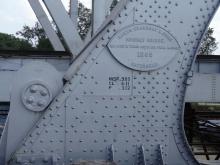
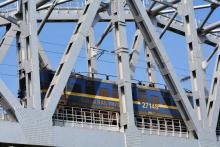
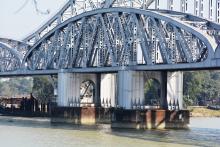
Comments
JUBILEE BRIDGE – SAMTREETI
JUBILEE BRIDGE – SAMTREETI SETU
ENGINEERING MASTERPIECES OF THE INDIAN RAILWAYS
Within a kilometre of the oldest Portuguese Church of eastern India, built in 1599 AD, and only two hundred metres from the classic Imambara at Hooghly, stands the “Jubilee” Railway Bridge, opened by Lord Dufferin, Viceroy and Governor General of India, in 1887, commemorating the Golden Jubilee year of the reign of Queen Victoria, then the Empress of India. Alas, though lakhs of tourists and pilgrims visit the town of Bandel every year, just thirty five kilometres north of Kolkata, very few pause to notice the engineering splendour of this iconic Railway Bridge, the first over the River Hooghly, between Bandel Jn. on the west to Naihati Station on the east bank. Commissioning of this bridge made it possible to connect North and West India to Bengal, Assam and the North East of the subcontinent, by rail transport for the first time in history.
It has always been a wonder as to why the Railway pioneers of the 19th century chose this particularly difficult site to ford the river, since at this location, the mighty Hooghly boasts of a perennial water flow of 27 metres depth. Being near the Bay of Bengal, the bridge substructure regularly suffers from the stresses emanating from repeated tidal movement. There is a belief that the Indian Railway Engineers of yore wanted to present their beloved Monarch a gift of unparalleled engineering accomplishment, on the Golden Jubilee year of her reign, as a befitting salute from her loyal subjects.
Jubilee Bridge has a cantilever truss structure, constructed exclusively by riveting. Its unique construction includes pendulum bearings, which perhaps are not seen in any other bridge in the country. The bridge abutments are made of brick masonry whereas the piers are partly of steel.
Opened to traffic on 16th February, 1887 the bridge was designed by Bradford Leslie and A. M. Rendel. Fabrication and erection were completed within a record period of five years. The bridge has a central span of 360 feet length and two side spans of 420 feet each. In 1910, a gauntleted track was laid on the bridge to allow wider rolling stock.
In 1999, after having served the nation for over a century, the need for replacement of the Jubilee Bridge was acutely felt by the Indian Railways. Therefore, during 1999-2000, a new double line bridge was sanctioned to be built. Named Sampreeti Setu, the new bridge is located by the side of the old bridge. With a Double-D well foundation, this bridge comprises of two end- spans of 132.5 metres each and a central span of 150 metres.
Inspired by the world-renowned Sydney Harbour Bridge in Australia, Sampreeti Setu has been designed with a continuous steel bow-string superstructure, with open web girder of 417 metres length and height of 45 metres. A span arrangement of such dimensions has not been successfully accomplished in Indian Railways or elsewhere in India before.
Another landmark achievement of the new bridge is of the use, for the first time in the Indian Railways, of spherical bearings. This has been done keeping in mind the vagaries of this location.
As the sun went down, at 15.10 hours on 17th April 2016, 13141 Up Teesta Torsa Express became the last passenger carrying train to cross the Hooghly over the historic Jubilee Bridge. With this, the curtain came down upon this great saga of railway engineering. The same afternoon, one of the most aesthetic bridges of modern India, the Sampreeti Setu, was simultaneously operationalised, with the passing of the Bandel-Naihati Dn. EMU at 14.00 hours, first passenger train over it.